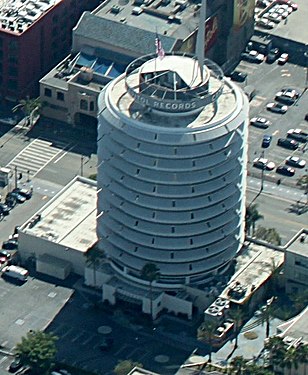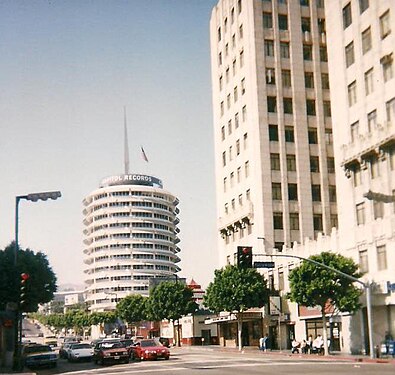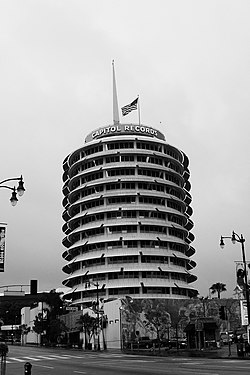| Capitol Records Building | |
|---|---|
 | |
|
| |
| Alternative names | Capitol Records Tower Capitol Tower |
| General information | |
| Type | Commercial offices |
| Architectural style | Googie architecture |
| Location | 1750 Vine Street Los Angeles, California |
| Coordinates | 34°06′11″N 118°19′34″W / 34.103085°N 118.326189°W |
| Construction started | 1955 |
| Completed | 1956 |
| Owner |
Argent Ventures 50% Universal Music Group 50% [1] |
| Height | |
| Antenna spire | 46 m (151 ft) |
| Technical details | |
| Floor count | 13 |
| Lifts/elevators | 3 |
| Design and construction | |
| Architect(s) | Welton Becket and Associates |
| Designated | November 15, 2006 |
| Reference no. | 857 |
| References | |
| [2] [3] [4] | |
The Capitol Records Building, also known as the Capitol Records Tower, is a 13-story tower building in Hollywood, California. Designed by Louis Naidorf of Welton Becket Associates, it is one of the city's landmarks. [5] Construction began soon after British music company EMI acquired Capitol Records in 1955, and was completed in April 1956. Located just north of the Hollywood and Vine intersection, the Capitol Records Tower houses the consolidation of Capitol Records' West Coast operations and is home to the recording studios and echo chambers of Capitol Studios. The building is a Los Angeles Historic-Cultural Monument and sits in the Hollywood Boulevard Commercial and Entertainment District. It has been described as the "world's first circular office building." [6]
The building is known as "The House That Nat Built" [7] [8] due to the vast numbers of records and amounts of merchandise Nat King Cole sold for the company.
Design
The building's design is on the graduate school drawings of Lou Naidorf who, as the primary architect, designed the first circular office building when he was 24 years old. [9] [10] The wide curved awnings over windows on each story and the tall spike emerging from the top of the building resembles a stack of records on a turntable with the spindle pointing skyward. [11] This resemblance, however, was coincidental, as Welton Becket kept the client's identity secret. Upon first seeing the design, Capitol Records' president Glen Wallichs insisted on a rectangular building, so Naidorf provided Wallichs with both. Wallichs presented both designs to his lender, who felt the round design would attract attention, which would make it easier to lease. Wallichs conceded, choosing Naidorf's initial round design. [12] The rectangular ground floor is a separate structure, joined to the tower after completion.
The 13-story conforms to the 150-foot (46 m) zoning height limit in place at the time of its construction. Height restrictions were lifted in 1956. [13] The thirteenth floor of the tower is the "Executive Level" and is represented by an "E" in the building's two elevators. [14]
Notable features
The blinking light atop the tower spells out the word "Hollywood" in Morse code. (.... --- .-.. .-.. -.-- .-- --- --- -..) [15] This was an idea of Capitol's then-president, Alan Livingston, who wanted to advertise Capitol's status as the first record label with a base on the west coast. It was switched on by Leila Morse, granddaughter of Samuel Morse. [11] During 1992, the light blinked "Capitol 50," in honor of the label's fiftieth anniversary. [16] A black-and-white graphic of the building appeared on the albums of many Capitol recording artists, with the phrase, "From the Sound Capitol of the World".
In April 2011, Capitol Records and artist Richard Wyatt Jr. restored his Hollywood Jazz Mural on the south wall of the Capitol Records building. [17] Restored in hand-glazed ceramic tile, the mural spans 26 by 88 feet (7.9 by 26.8 m) [18] Entitled "Hollywood Jazz: 1945-1972", it presents "larger than life" images of a number of notable jazz musicians.
Capitol Studios
The building houses the Capitol Studios, a recording facility which includes eight echo chambers engineered by guitarist Les Paul and three main studios, A, B, and C. Frank Sinatra had a close association with the studios, and the Georg Neumann U 47 microphone he carried around with him is there, often used and maintained for studio sessions. The first album recorded in the tower was Frank Sinatra Conducts Tone Poems of Color. In 2012, Studio A received a new AMS Neve 88R mixing console, designed and built for Al Schmitt and Paul McCartney. [19]
Recent history
In September 2006, EMI sold the tower and adjacent properties for US$50 million to New York developer Argent Ventures. The studio claimed that noise from construction of a condominium threatened it, as well as an underground parking lot by building firm Second Street Ventures would have heavy equipment working within 18 feet (5.5 m) of its renowned underground echo chambers, which are themselves over 20 feet (6.1 m) below ground level. [20]
In November 2012, Steve Barnett was announced as the new Chairman and CEO of the Capitol Music Group and the company stated his office would be in the building. [21] This coincided with Capitol Music Group becoming part of Universal Music Group, assuring its new parent company two Los Angeles headquarters.
Gallery
-
An aerial view of the Capitol Records Building
-
Viewed from Hollywood and Vine, 1997
-
Parking lot mural titled Hollywood Jazz
-
Taken on 2006-03-28
References
- ^ Universal Music Group Buys 50% Stake in Owner of Hollywood's Iconic Capitol Records Building Archived February 10, 2023, at the Wayback Machine (Retrieved from CoStar.com news service on 16 October 2023)
- ^ "Emporis building ID 116599". Emporis. Archived from the original on November 7, 2017.
- ^ Capitol Records Building at Glass Steel and Stone (archived)
- ^ "Capitol Records Building". SkyscraperPage.
- ^ Hawthorne, Christopher (May 29, 2011). "Critic's Notebook: Hollywood landmark at a crossroads". Los Angeles Times. Archived from the original on January 9, 2018. Retrieved April 18, 2013.
- ^ "World's First Circular Building Readied Here". Los Angeles Times (1923-1955). April 8, 1956. ProQuest 166913154. Retrieved June 10, 2020.
- ^ Congressional Record. Retrieved December 24, 2013.
- ^ Seetoo, John. "A Visit to Capitol Studios". PS Audio. PS Audio. Archived from the original on October 27, 2021. Retrieved October 7, 2021.
- ^ MillenniumHollywood (October 23, 2012). "Millennium Hollywood: Lou Naidorf" (Video upload). YouTube. Google, Inc. Archived from the original on October 17, 2013. Retrieved September 25, 2013.
- ^ Hundley, Jessica (January 16, 2003). "A star was born". Los Angeles Times. Archived from the original on March 17, 2016. Retrieved September 25, 2013.
- ^ a b Huell Howser; Sue Satriano (1988). Exploring L.A. with Huell (video). Hollywood, California: KCET. Archived from the original (mp3) on December 8, 2007. Retrieved September 22, 2010.
- ^ Myers, Marc. "The Truth About The Tower". Wall Street Journal. Dow Jones & Company, Inc. Archived from the original on October 6, 2021. Retrieved October 6, 2021.
- ^ Masters, Nathan (May 23, 2012). "L.A.'s Changing Skyline: A Brief History of Skyscrapers in the City of Angels". KCET. KCETLink. Archived from the original on February 3, 2016. Retrieved October 3, 2013.
- ^ "About". Capitol Records Building. Archived from the original on September 18, 2020. Retrieved June 10, 2020.
- ^ "Capitol Records Building Morse Code". Atlas Obscura. Archived from the original on June 10, 2020. Retrieved June 10, 2020.
- ^ MacMinn, Aleene (May 28, 1992). "Pop/rock". Los Angeles Times. ISSN 0458-3035. Archived from the original on December 21, 2016. Retrieved April 6, 2016.
- ^ "Capitol Records Jazz Mural restored!". Millennium Hollywood. Millennium Hollywood Partners. January 30, 2013. Archived from the original on May 25, 2013. Retrieved April 18, 2013.
- ^ Lewis, Randy (February 18, 2013). "'Hollywood Jazz' mural lives on more brightly". Los Angeles Times. Archived from the original on February 20, 2013. Retrieved April 18, 2013.
- ^ Brown, August (November 1, 2012). "Capitol Studios". Los Angeles Times. Archived from the original on October 19, 2014. Retrieved October 8, 2014.
- ^ Pool, Bob (June 18, 2008). "Capitol Fears For Its Sonic Signature". Los Angeles Times. p. B2.
- ^ Brown, August (November 26, 2012). "Steve Barnett to lead Capitol Music Group". Los Angeles Times. Archived from the original on November 29, 2012. Retrieved October 3, 2013.
External links
- Buildings and structures in Hollywood, Los Angeles
- Capitol Records
- Skyscraper office buildings in Los Angeles
- Headquarters in the United States
- History of Los Angeles
- Los Angeles Historic-Cultural Monuments
- Landmarks in Los Angeles
- Culture of Los Angeles
- Office buildings completed in 1956
- Welton Becket buildings
- Futurist architecture
- Modernist architecture in California
- Round buildings
- 1956 establishments in California



